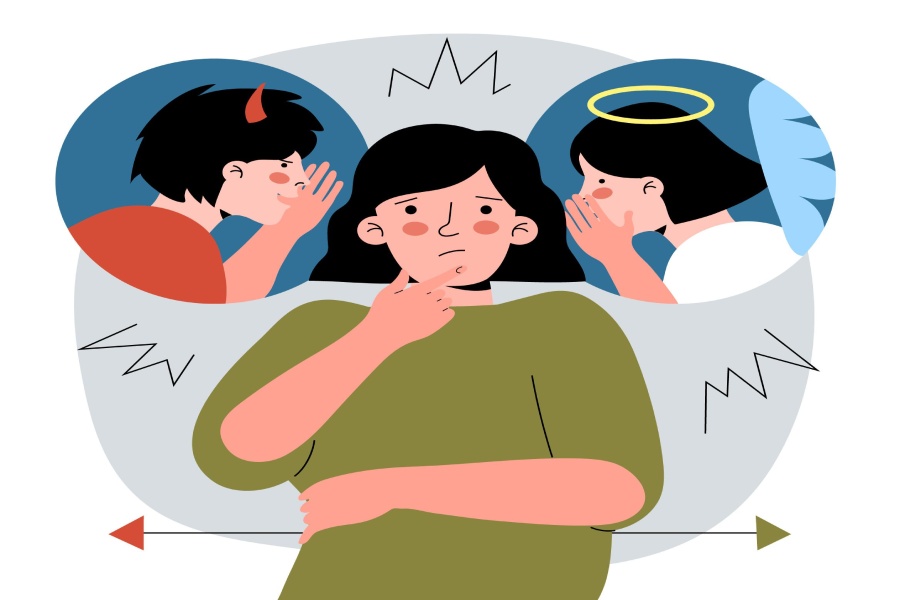Borderline Personality Disorder, abbreviated as BPD is a mental health condition characterized by severe and persistent problems across the interpersonal, cognitive, behavioral, and emotional functioning of an individual.
Here we will understand what is BPD using the following points:-
- History
- Clinical Features
- Causal Factors
- Impact on Life
- Coping strategies
History of Borderline Personality Disorder
The term Borderline personality has a rather quite a history which is confusing at times too. This term was originally used to refer to patients who were very challenging to deal with. “Borderline Personality” was proposed in the United States by Adolph Stern in 1938. He used the term “border” to describe a group of patients who fit neither into the psychotic or the psychoneurotic group and were on the “border” between both.
Later, the characteristics and the key clinical aspects of Borderline Personality Disorder were clarified and described by Gunderson and Kolb in 1978 and have since been incorporated into contemporary psychiatric classifications. (Hooley, Butcher, et al., 2017)

Clinical Features Of Borderline Personality Disorder
BPD Disorder Symptoms
The main symptoms of BPD include fear of abandonment, unstable relationships, unclear or shifting self-image, impulsive, self-destructive behaviors, self-harm, extreme emotional swings, chronic feelings of emptiness, and explosive anger.
People with Borderline Personality Disorder (BPD) often experience instability, with constant fluctuations in mood and behavior. They frequently feel isolated and unoccupied thus attaching themselves strongly to others. Their sense of self is fragile, thus leading them to form intense connections with others that they may later strongly reject. Conversely, they may desperately try to avoid abandonment, whether real or imagined. They exhibit impulsive behaviors such as reckless spending, binge eating, or erratic driving. Stress can trigger brief episodes of dissociation or paranoia, though these typically pass quickly. They undergo intense mood swings, sometimes leading to uncontrollable anger. Additionally, they may engage in self-harming behaviors or threaten suicide repeatedly.
Brain functioning
Researchers have found that individuals with BPD may experience challenges in the communication between emotion-regulating and decision-making regions of the brain, including the amygdala, hippocampus, and medial temporal lobes. This communication breakdown can lead to subtle yet significant consequences.
For instance, studies indicate that BPD patients often misinterpret facial expressions, attributing negative emotions to neutral ones. Additionally, chemical imbalances in the brain, particularly in processing or producing hormones like oxytocin and neurotransmitters like serotonin, are commonly observed in those with BPD. These chemicals play crucial roles in mood regulation, emotional responses, and social connections, thus proving that BPD is not something that is made up in anyone’s head. (O’Neill, A.; Frodl, T., 2012)
Comorbidity
Apart from their symptoms, there is an important clinical feature that needs to be understood. Borderline Personality Disorder is rarely diagnosed alone. It tends to be comorbid (exists simultaneously with) mood and anxiety disorders or even substance use disorders. (Hooley, Butcher, et al., 2017)
In the “Comorbidity study of borderline personality Disorder done by Shen, Hu, and Hu in 2017, it was found that psychiatric comorbidities, including depressive disorder, bipolar disorder, anxiety disorder, sleep disorder, substance use disorder, and mental retardation were more common in the BPD clients than in the control clients.
What Causes Borderline Personality Disorder?
Other important causal factors in case of BPD
Family history
Environment, (social and cultural)
(National Institute of Mental Health)
Family History
People who have a close family member (sibling or parent) with this illness may be more likely to develop borderline personality disorder due to shared genetic factors.
In a study done by Gunderson in 2011, the risk of having a BPD diagnosis was found to be four times higher in the biological relatives of clients with BPD than it was in the relatives of people who did not have the diagnosis of BPD.
This does not mean every person who is in a close family of BPD clients will have the same diagnosis. Still, it just means that genes do play a crucial role in determining the vulnerability of an individual toward BPD.
Environment (social and cultural)
Child Maltreatment and other extreme early life experiences have long been linked to BPD. Many people with BPD have reported to having experienced traumatic life events such as abuse, abandonment, or hardship during childhood. Two prospective study showed that this childhood trauma and adverse conditions have increased the risk of developing BPD in adulthood.(Johnson, et al,1999)
One may be at higher risk for BPD if you are part of a community with unstable relationships. People are at a higher risk for getting borderline personality disorder if they have suffered from abuse or neglect. Living with parents or guardians who have a history of substance use disorder or criminal activity may increase the risk as well.
Also check: Counselling Psychology Internship

Impact on life
People with BPD show an unstable and impulsive pattern of behavior which in turn affects their mood, interpersonal relationships, and their self-image too. Borderline personality disorder usually begins by early adulthood. The condition is most serious in young adulthood. Mood swings, anger and impulsiveness often get better with age. But the main issues of self-image and fear of being abandoned, as well as relationship issues, go on.
This “Affective instability” is also characterized by drastic and rapid shifts from one emotion to the other. The emotions felt are uncontrollable too.
They often have feelings of emptiness and difficulty of forming a sense of who they are. They struggle with an unclear self-image and may perceive themselves negatively.
People with BPD find it challenging to keep healthy personal relationships. They are quite intense and stormy. This involves the over-idealization of friends or lovers that later end in bitter disillusionment, disappointment, and anger (Gunderson et al, 1995)
One important factor that impacts their social and personal life is the fear of abandonment. Even though they want to have loving and lasting relationships, the fear of being abandoned often leads to mood swings and anger. It also leads to impulsiveness and self-injury that may push others away.
With the insecure self-image, hey quickly perceive rejection in the behaviors of others and when they do, they feel intense fear or anger.
The impulsivity in the behaviors of people with BPD has a significant impact on their lives. They may rapidly respond to environmental triggers without thinking or caring about long-term consequences. They may also indulge in self-destructive behaviors which could lead to serious injuries. (Hooley, Butcher, et al., 2017)
BPD Coping Strategies
(National Institute of Mental Health)
People with borderline personality disorder may need intensive, often inpatient care to manage severe symptoms, while some others may be able to manage with outpatient care.
Psychotherapy is usually the main treatment for people with borderline personality disorder.Cognitive Behavioural Therapy is used to help identify and change core beliefs and behaviors that comes from inaccurate perceptions and problems interacting with others.
Dialectical behavior therapy is extensively used in the treatment of BPD. Dialectical behavior therapy (DBT) is a structured outpatient treatment based on cognitive-behavioral principles developed by Dr Marsha Linehan. The term “dialectical” means the interaction of conflicting ideas. Within DBT, “dialectical” refers to the usage of both acceptance and change together as the need for improvement. Dialectical behavior therapy aims to address the symptoms of BPD by replacing maladaptive behaviors with healthier coping skills, such as mindfulness, interpersonal effectiveness, emotion regulation, and distress tolerance. Research suggests that DBT is effective in reducing psychiatric hospitalization, substance use, and suicidal behavior in people with BPD. It also reduces treatment dropout rates, feelings of anger, and interpersonal difficulties. (Guilford Press, 1993).
In the case of BPD, medications are usually not used, but some psychiatrists might recommend the same.
Apart from helping the clients diagnosed with BPD it is also crucial to understand the role the family members play in the life of the clients. They must learn how to support in correctly learn about the illness, offering emotional support, and encouraging them in the course of treatment are a few things the support giver could learn. These things can be learned through the medium of therapy.
This particular disorder might sound strange to a few, doesn’t mean that it should get a different treatment than how anxiety or depression might be perceived. Personality here refers to “the patterns of thinking, feeling, and behavior” No one acts the same all the time. But there are some consistent behaviors that we may exhibit. Personality Disorder means that the pattern of behavior and thinking is significantly deviated from the expectations of society. Having said that it does not mean that there is fundamentally wrong with someone. These patterns of thought and behavior can be changed and regulated if treated well. Thus it is important to destigmatize, understand, identify, and get correct help if one sees these kind of behaviors around, without abandoning or blaming the person.
In conclusion, Borderline Personality Disorder (BPD) is a complex and often misunderstood mental health condition that can significantly impact an individual’s life. It is crucial to approach those with BPD with empathy, understanding, and support, recognizing that their experiences are valid and real. Increased awareness and destigmatization surrounding BPD can pave the way for more effective treatment, fostering a compassionate and inclusive society that promotes mental well-being for all.
References
Gunderson, J. G., Zanarini, M.C., & Kisiel, C.L. (1995). Borderline Personality Disorder. In W.J. Livesly (Ed’0, the DSM-IV personality disorder (pp.141-57)
Hooley, J.M., Butcher, J.N., Nock, M.K., Mineka, S., (2017) Abnormal Psychology, 17th Edition, pg 387.
Johnson, J.G., Cohen, P., Brown, J.,m Smails, E.M. & Bernstein, D. P., (1999) Childhood maltreatment increases the risk for personality disorders during early adulthood. Arch, Gen Psychiatry.
National Institute of Mental Health – Borderline Personality Disorder
Skills training manual for treating borderline personality disorder. (1993). . Guilford Press.
O’Neill, A.; Frodl, T.(2012) Brain Structure and function in borderline personality disorder.

